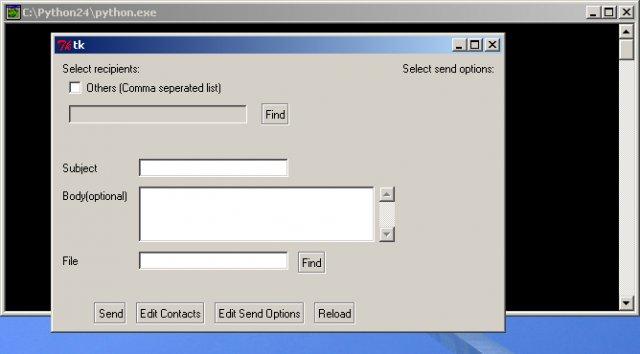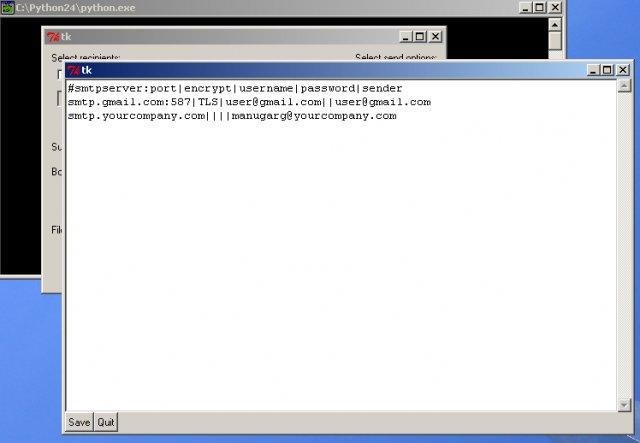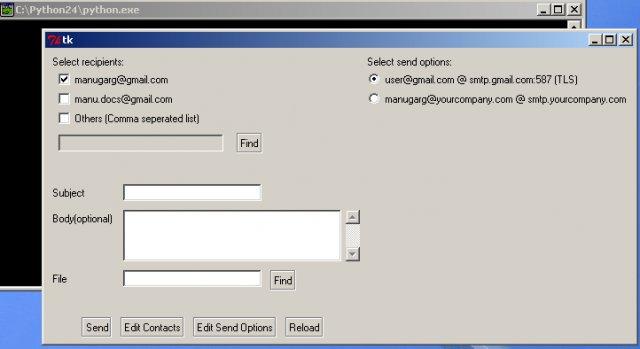About
pyMailer
pyMailer
is a cute little app which strives to do just one thing well.
That
one thing is sending mails. pyMailer is written in python which
automatically provides for platform independence.
Installation
pyMailer
comes in 2 packages:
-
python scripts and
-
win32 executables created by py2exe.
To
run scripts version, you need python 2.2 or higher version.
Installation is pretty simple: just download the zipped files and
extract to
some directory. You can run 'installsendto' to add a link to pymailer
in SendTo on windows. This comes pretty handy for sending files quickly.
Usage
Command
Line Version:
It's
mostly meant for unix. (who uses commands on windows anyways ;-)).
Usage: pymailer.py [options] to [to ...]*
Options:
-h, --help Print this message and exit.
-a Attachment. Use multiple '-a' options to attach multiple files
-s,--subject
Subject
-f,--from Fromaddr
--smtpstr Smtp string in the format 'server:port|encrypt|user|password'
--smtpsvr Smtp server in the format server:port.
All other fields are considered empty in smtpstr
`to' is the email address of the recipient of the message, and multiple
recipients may be given.
Examples:
To send using local smtp server
-
python
pymailer.py -s
"system configuration file" -a /etc/sysctl.conf \
-f root manugarg@gmail.com </dev/null
To send using your company's
smtp server -
python
pymailer.py -s
"System
logs" -a /var/log/messeges -f root --smtpsvr\
"smtp.yourcompany.com:25" manugarg@gmail.com </dev/null
To send using gmail's smtp
server -
python
pymailer.py -s
"other mail" -a $HOME/notes -f manugarg@gmail.com --smtpstr \
"smtp.gmail.com:587|TLS|manugarg@gmail.com|mypassword"
manu.garg@work.com </dev/null
Graphical
Interface
This version has rather more features and as a matter of fact I started
writing this first and command line version was a side product of
development of this version.
$python
pymailerw.py [file1] [file2] ...
or, if you are using executables on windows
pymailerw.exe
[file1] [file2] ...
First run:

This
shows the screenshot of the first run, with no saved configuration. You
can
specify recepeints in by checking the ‘Others’ box
or you can configure 'Contacts' list for quick selection. To
be able to send
mail you need to configure some SMTP options first.
Editing
Send Options:
This
version reads sending
options from a configuration file which is stored in
your profile directory. You can edit this file directly from the main
window by clicking 'Edit Send Options' button. This opens up a new
window in which you can add/edit smtp options. You specify smtp options
using the same smtp string format. We'll talk more about smtp string in
coming section.

Once you are finished with editing, save the file and exit. To effect
the changes, you will have to click on 'Reload' button on main
screen.
Editing
Contacts:
This is not a requirement, but it comes handy when you send mails to
same email addresses frequently. This configuration is also stored in a
file. To edit this file click on 'Edit Contacts'. It will pop up a
window where you can edit these options.

First 5 contacts from this file, appear on main window. Rest you can
select by clicking on 'Find' button next to 'Others' textbox.
All of these configurations are saved in you profile directory. Next time when
you open pymailerw, these configurations are automatically read and
resulting window looks something like below:

If you specify a filename at command line, that will appear inside
‘File’ textbox
and file name is automatically added to
the ‘Subject’ field. This is what happens when you
send a file using 'SendTo' list in Windows.
SMTP String
SMTP string is ubiquitous in pyMailer. It’s a convenient
way to specify smtp options.
'server:port|encrypt|user|password'
| server:port |
SMTP server and port. If
this field is left empty, it is assumed to be local server. |
| encrypt |
Specifies if SMTP server
uses encryption. If this field is empty, no encryption is used.
Currently only ‘TLS’ encryption is supported. |
| user |
It specifies username if
server requires authentication. If this field is
empty, no authentication is used. |
| password |
Password if
authentication is required. If this field is empty and
‘user’ is non-empty,
user is prompted for the password before sending mail. |
Questions/Suggestions/Bugs
I can be reached at manugarg at gmail dot com.
I'll be pleased to help you with anything related to pymailer.